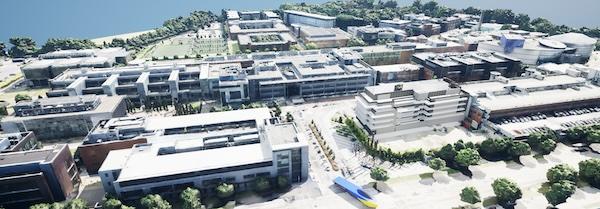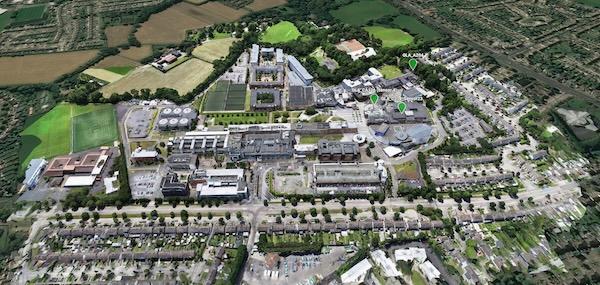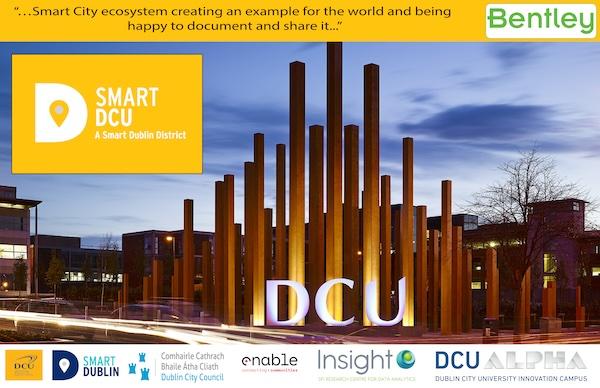
Bentley Systems Prathamesh Gawde
Prathamesh Gawde is a senior product marketer at Bentley Systems. He earned a master’s degree in management studies with an emphasis in marketing and a bachelor’s degree in mechanical engineering from the University of Mumbai. Dublin City University Seeks to Advance Infrastructure Digital Twins by Testing AI for Smart City InnovationsAugust 16th, 2024 by Prathamesh Gawde
Bentley Infrastructure Cloud and iTwin Technology Helped Streamline Digital Data Integration and Improve Visualization Project Summary Organization: Dublin City University Solution: Facilities, Campuses, and Cities Location: Dublin, Ireland Project Objectives:
Project Playbook: AssetWise, iTwin, iTwin Capture Fast Facts
Callout Quote: “By utilizing the Bentley ecosystem, we were able to create a detailed 3D model of the university campus and integrate diverse IoT data feeds from various vendors in a fast, efficient manner.” – Kieran Mahon, Smart DCU Project Facilitator, Dublin City University  Image caption/courtesy 1: Dublin City University (DCU) is collaborating with Bentley Systems to create a campus digital twin as part of its Smart DCU initiative. Image courtesy of Dublin City University.Collaborating on the Future of Infrastructure Digital Twins Understanding that digital twins are the future of infrastructure, Dublin City University (DCU) teamed up with Dublin City Council, Insight SFI Research Centre for Data Analytics, and Bentley Systems to push the boundaries of digital twins. DCU sought to advance its existing Smart DCU program, which is utilizing the university campus as a test site to explore and evaluate the latest advancements in smart city solutions. This collaborative initiative will investigate the power of artificial intelligence (AI) and immersive digital twin technology using DCU as a city microcosm for developing intelligent and sustainable urban spaces.
Kieran Mahon, Smart DCU project facilitator at Dublin City University, said, “The DCU campus [is] an ideal living laboratory for this purpose, as it replicates the essential features of a real city, including accommodations, roads, retail areas, and other urban amenities, albeit on a smaller scale.” The project involves establishing AI algorithms and digital twins to simulate and visualize scenarios and use predictive analytics to improve mobility and safety on campus, as well as enable real-time monitoring of building performance, occupancy, and air quality. The goal is to gather digital insight to help the university better understand how people, traffic, and buildings interact within the built environment, making more informed decisions. Focusing on exploring AI and 3D immersive technologies to visualize complex environmental and contextual data in real time, the intelligent collaborative project aims to showcase an exemplary smart city ecosystem. Professor Tomas Ward, site director of the Insight SFI Research Centre for Data Analytics at DCU, said, “The combination of Bentley’s world-class expertise in digital twin technologies with Insight’s world-class expertise in data analytics and AI through the team at DCU unlocks potential that would not otherwise have been accessible. We are delighted to have this collaborative relationship and will continue to work closely with Bentley to create next generation solutions for smart city deployment.” Bringing Together Siloed Data in One Place DCU began by using various Internet of Things (IoT), radar, and environmental sensors to collect and monitor data. Some of this data related to noise, occupancy, traffic patterns, mobility, waste collection, energy usage, and other relevant measurements to support intelligent campus functionality. In some cases, it required installing new traffic lights and infrastructure. While each sensor individually achieved its data collection and measurement goals, this information was disparate, limiting the potential for smart campus operations. “It became evident that a holistic approach was necessary to maximize the potential of these individual initiatives,” said Mahon. To establish their smart city initiatives, DCU required insight into real-time visual data for holistic decision-making. The sheer volume of the data generated was also problematic, surpassing the human capacity for analysis. To maximize data capture and analysis potential, DCU realized that they needed to integrate this voluminous, multisourced, siloed data. “There was a need for a platform that could integrate and leverage the data from these diverse sources, creating a more efficient and comprehensive smart city solution,” said Mahon. The integrated data platform also needed to harness the power of AI, establishing a fully immersive digital twin environment to visually analyze the data and provide actionable intelligence to optimize campus operations, enhance resource allocation, and ensure sustainable growth.  Image caption/courtesy 2: Harnessing the power of artificial intelligence analytics with Bentley’s iTwin technology provided an immersive visual environment, enabling real-time insight into on-site operations for smart campus solutions. Image courtesy of Dublin City University. Leveraging AI and Digital Twin Technologies DCU selected Bentley’s AssetWise, part of Bentley Infrastructure Cloud, and iTwin applications to create a campus model integrated with IoT data, generating an immersive digital twin. Incorporating AI into the digital twin enabled a comprehensive, real-time 3D perspective of the campus, facilitating the understanding of the various factors that influence operational efficiency and overall experience of the people on campus. “It’s not just about engaging visualizations or simple gauges, it’s about identifying patterns and mismatches to drive meaningful action,” said Mahon. Using Bentley’s digital twin technology, the team built a 3D campus model and overlaid it with real-time IoT sensor data that can be used for operational efficiency, decision-making, and planning. “By utilizing the Bentley ecosystem, we were able to create a detailed 3D model of the university campus and integrate diverse IoT data feeds from various vendors in a fast, efficient manner,” said Mahon. Working within Bentley’s iTwin Platform enabled valuable AI insight to be presented in the digital twin. Real-time AI data analysis is conducted, and the resulting insights are presented visually in an immersive digital environment where patterns and discrepancies can be detected, ultimately leading to actionable decisions. This AI-driven digital twin allows for the development of smart and adaptive systems that respond dynamically to changing conditions, optimizing energy usage and enhancing user experiences. “We believe that AI-driven solutions hold the key to unlocking a new era of urban management,” said Mahon. The collaboration with Bentley showcases the potential of digital twins for campuses and cities.  Image caption/courtesy 3: DCU selected Bentley’s open 3D and reality modeling technology to create a campus model integrated with IoT data, generating an immersive digital twin on the iTwin Platform. Image courtesy of Dublin City University. Providing Insight for Intelligent Sustainable Cities Cooperating with Bentley and Insight, DCU has harnessed the potential of data analytics, IoT, and digital twins in an interconnected virtual environment to create a smarter, more sustainable campus. Leveraging the power of advanced technologies has unlocked numerous opportunities and benefits for DCU, enhancing efficiencies, streamlining processes, and improving decision-making. DCU has validated the effectiveness of their digital twin application, achieving better mobility, connectivity enhancements, academic integration, and cost savings, improving the daily experiences of university students, staff, and visitors. “These deliverables demonstrate how Smart DCU drives collaboration, implements cutting edge technologies, improves operational efficiencies, shares knowledge, and enhances urban infrastructures to create smarter, more sustainable, and enjoyable campuses and cities,” said Mahon. Digital twins bring data to life, enabling the identification of anomalies, emerging trends, and valuable insights into urban functioning. Visualizing live environmental data in an immersive context demonstrates the value of digital twins, balancing user well-being with resource optimization. The DCU digital twin serves as a catalyst for numerous environmental and sustainability initiatives, democratizes data visualization, and empowers agencies and individuals to implement intelligent processes, actively shaping the future of their cities. Proven to deliver tangible outcomes that are measured and assessed, this collaborative smart campus initiative has the transformative power to reshape urban spaces into intelligent, sustainable cities. “Embracing [AI and digital twin] technologies unlocks the potential for widespread understanding, collaboration, and innovation, creating a brighter future for urban environments,” said Mahon. Dr. Ali Intizar, assistant professor at the School of Electronic Engineering, is also a funded investigator at the Insight SFI Centre for Data Analytics and leads the Smart DCU digital twin initiative. He explained that the goal of the project is “to transform 3D models into dynamic digital twins by integrating IoT data, followed by the application of AI and machine learning methods to develop a cognitive digital twin. This advanced notion of a cognitive digital twin is set to leverage an array of technologies, such as 3D visualization, analysis of IoT data, and AI. The goal is to process raw sensory data into meaningful insights, which will then enable automated intelligent services at the device level.” |
|
|
|||||
|
|
|||||
|
|||||
%d bloggers like this:






